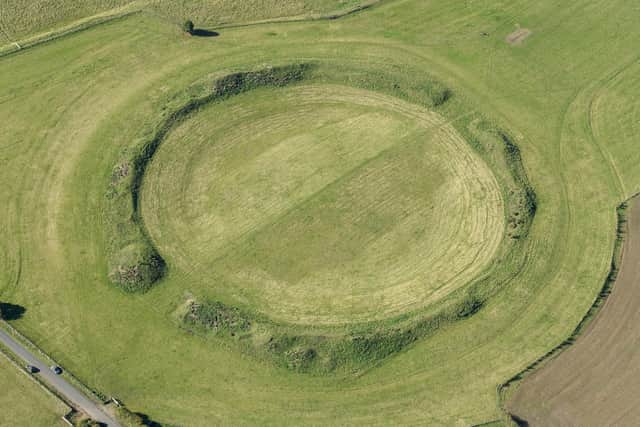Thornborough Henges near Ripon gifted to the nation to secure their future
and live on Freeview channel 276
The henges will join Stonehenge, Iron Bridge, Dover Castle, Kenwood and numerous Roman sites on Hadrian’s Wall within the National Heritage Collection.
English Heritage will be welcoming the public to the henges and sharing the site’s stories with visitors.
Advertisement
Hide AdAdvertisement
Hide AdThe Thornborough Henges complex, near Ripon, is an extremely important site, consisting of three giant, circular earthworks (known as ‘henges’) each more than 200m in diameter.


Dating from 3500 to 2500 BC, the henges are of outstanding national significance.
The earthworks are thought to have been part of a 'ritual landscape', comparable with Salisbury Plain in south-west England, and are probably the most important single ancient site between Stonehenge and the Orkney Islands in Scotland.
Now, the central and southern henges have been gifted by sustainable building materials and construction solutions business, Tarmac, into the legal ownership of Historic England, the government’s heritage advisor, as part of the National Heritage Collection and are managed by English Heritage.
Advertisement
Hide AdAdvertisement
Hide AdLightwater Holdings, a local construction materials provider, house builder and leisure group, has also gifted parts of the wider monument to Historic England.


The henges are now under the care of English Heritage and are free to visit.
As part of its interpretation programme, the charity will share with visitors Thornborough Henges’ stories and explain its significance.
Although the henges have remained remarkably well preserved over thousands of years, the central and southern henges were added to Historic England’s Heritage at Risk Register in 2009 due to historic erosion caused by livestock and rabbits.
Advertisement
Hide AdAdvertisement
Hide AdHistoric England has been working with landowners Tarmac for a number of years to secure the future of Thornborough Henges, so that they can be enjoyed now and protected for future generations.


The donation of the henges to the nation is the best option to secure the monuments’ long-term future and will lead to it being removed from the Heritage at Risk register.
Duncan Wilson, Historic England’s Chief Executive, said: “Thornborough Henges and their surrounding landscape form part of the most important concentration of Neolithic monuments in the North of England.
"They are a link to our ancient ancestors, through thousands of years, inspiring a sense of wonder and mystery.
Advertisement
Hide AdAdvertisement
Hide Ad“We are thrilled to have acquired this highly significant site for the nation, ensuring that these magnificent monuments are safe and will be preserved for generations to come.”


Kate Mavor, English Heritage’s Chief Executive, said: “Thornborough Henges is one of the most important ancient sites in Britain and yet almost completely unknown – we are looking forward to sharing its significance, its stories and its secrets with the public.”
Rishi Sunak MP, whose Richmond (Yorks) parliamentary constituency includes the henges site, said: “The Thornborough Henges site has enormous potential to help tell the story of ancient Britain and I very much welcome this announcement about its future – its safeguarding and preservation for the nation.
Stuart Wykes, Director of Land and Natural Resources at Tarmac, said: “Tarmac has had a long-standing commitment to secure the long-term future of the monuments and we're delighted to gift this incredibly important historical site to Historic England.
Advertisement
Hide AdAdvertisement
Hide Ad“With its help, the heritage of the central and southern henges at Thornborough will be protected and preserved for years to come.
“We hope the public enjoy the breath-taking ancient site once it is accessible for them to enjoy.”
James Staveley, Chairman of Lightwater Holdings, said: “The company is delighted to have played its part in helping to preserve the Henges for future generations.
“Historic England’s ownership of this incredibly important monument brings with it the necessary expertise and resources to ensure its long-term protection and management for the benefit of the public.
Advertisement
Hide AdAdvertisement
Hide Ad“We look forward to working with Historic England and English Heritage to help improve the public’s access and enjoyment of the site.”
ABOUT THORNBOROURGH HENGES
Thornborough Henges sit in an ancient, ritual prehistoric landscape, marked by different monuments, running from Ferrybridge to Catterick– a kind of fore-runner to the A1.
They are massive man-made Neolithic and early Bronze Age earth works, built on Thornborough Moor, near to the River Ure and are unparalleled in their size, alignment and degree of preservation.
Just like Stonehenge and the standing stones at Avebury, a huge amount of people power was channelled into their construction – testament to their significance to the society that created them.
Advertisement
Hide AdAdvertisement
Hide AdThe Thornborough Henges complex consists of three giant, circular earthworks, roughly aligned north-south.
The central and southern henges have been actively farmed and so are not as well preserved as the northern Henge.
The central henge is still large and impressive with high banks.
Tarmac is currently working with English Heritage and Historic England to repair the banks over the next 18 months.
Advertisement
Hide AdAdvertisement
Hide AdToday all three henges are clearly visible as massive circular banks, ranging in height up to four metres high, with encircling ditches of various depths – but thousands of years ago, they would have stood on a low promontory overlooking wetlands.
Evidence suggests they may have been covered in a mineral called gypsum and would have glowed white for miles around.
Archaeological effects and prehistoric finds in this area suggest the henges were probably built as ceremonial or ritual centres; the communal act of building may have had an important social role.
They may also have served as trading centres and meeting places.
Excavations around the henges have also revealed a possible timber post avenue, an oval burial monument and several round barrows.